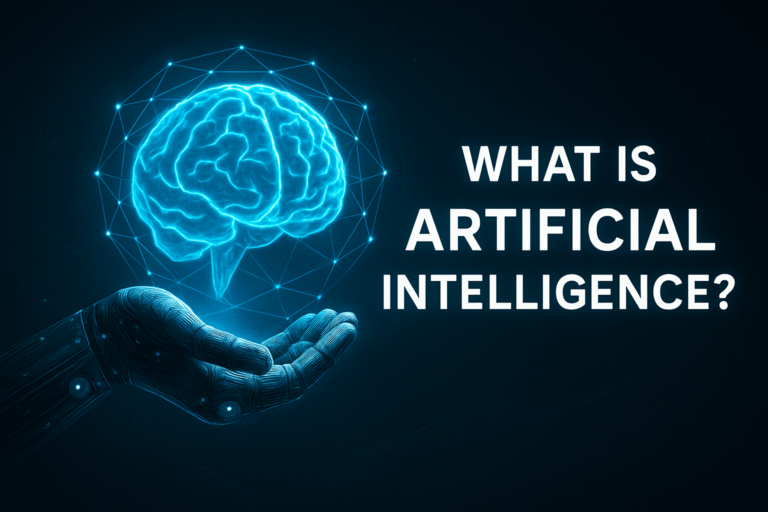Quantum Computing: Unveiling the Quantum Domain
Quantum computing represents a paradigm shift in our computational capabilities, transcending the limitations of classical computing to solve complex problems with unprecedented efficiency. At its core, quantum computing harnesses the principles of quantum mechanics, the fundamental theory in physics that describes nature at the most minor scales, such as particles at the atomic and subatomic levels. This introduction explores the overview of quantum computing, delving into its significance and the pivotal role of quantum mechanics in computing.

Quantum mechanics introduces concepts like superposition and entanglement, which quantum computers exploit to perform calculations.
Unlike classical computers, which use bits as the smallest unit of information (each bit being a 0 or a 1), quantum computers use qubits.
Thanks to superposition, qubits can represent and store information in a combination of 0 and 1 simultaneously.
This capability allows quantum computers to process many possibilities simultaneously, making them exponentially faster than classical computers for specific tasks.
The significance of quantum computing lies in its potential to revolutionize various fields by solving problems considered intractable for classical computers.
The implications are profound, ranging from drug discovery and material science to cryptography and optimization problems.
Quantum computing promises to unlock new domains in scientific research, providing the tools to simulate the physical world with high fidelity and quickly solve complex computational problems.
Furthermore, quantum computing stands to redefine the era of information security.
It challenges classical encryption methods but also paves the way for quantum encryption techniques, offering unprecedented levels of protection.
The advent of quantum computing is not merely an evolution in computational speed and efficiency; it represents a fundamental shift in how we process information, offering a glimpse into a future where the barriers of computational complexity are significantly diminished.
However, realizing quantum computing’s full potential requires overcoming significant technical challenges, including stabilizing qubits and scaling up quantum systems.
The field is in its infancy, with researchers worldwide working diligently to address these challenges. The progress thus far points to a promising future, with quantum computing poised to become a transformative force in technology and society.
1. The Fundamentals of Quantum Computing
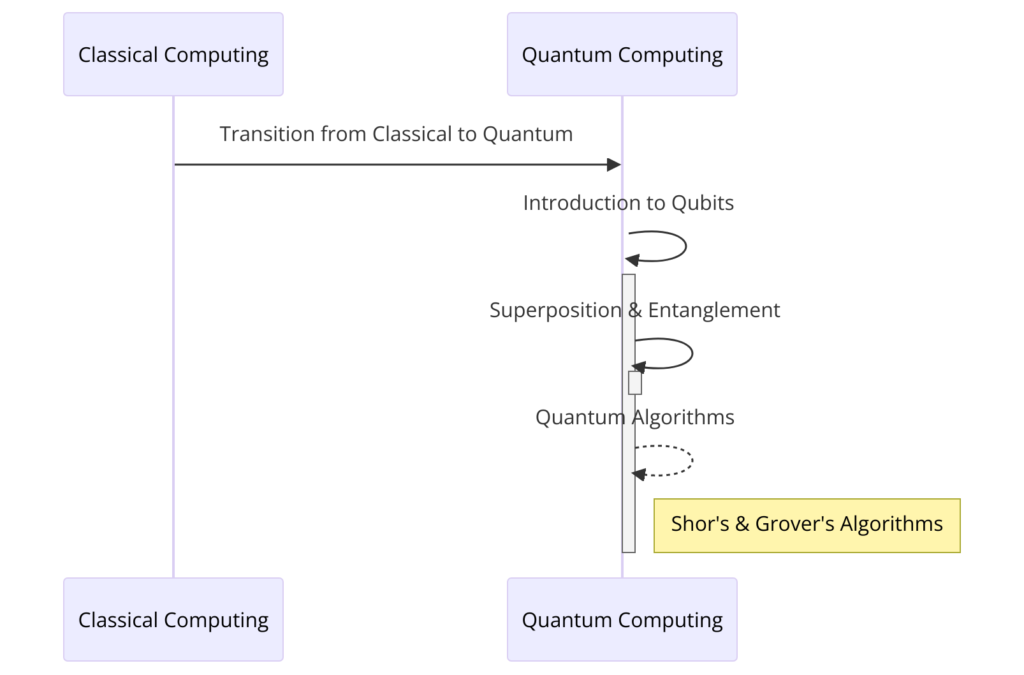
From Classical to Quantum: The Shift in Computing
The evolution from classical to quantum computing marks a significant leap in our approach to solving complex problems.
Classical computing, the backbone of the digital age, relies on bits for processing information. These bits are binary, existing in one of two states: 0 or 1.
The limitations of classical computing become apparent when dealing with problems that require processing vast amounts of data or performing complex calculations, where the binary nature of bits restricts computational efficiency and speed.
Quantum computing, in contrast, introduces a new unit of information—the qubit (quantum bit). Unlike classical bits, qubits exploit two fundamental principles of quantum mechanics: superposition and entanglement.
- Superposition allows a qubit to exist in a state of 0, 1, or any quantum superposition of these states. This means a qubit can represent both 0 and 1 simultaneously, a property that enables quantum computers to process many potential outcomes at once. When multiple qubits in superposition are used together, they can process exponentially more information than the same number of classical bits, offering a glimpse into quantum computing’s potential to solve specific problems much more efficiently than classical computers.
- Entanglement is another quantum phenomenon in which qubits become interconnected so that the state of one (no matter how far apart) can depend on the state of another. This unique property allows for the synchronization of qubits across vast distances, paving the way for complex computations far beyond the reach of classical computing. Entanglement is central to many quantum computing algorithms and critical in quantum encryption and quantum networking.
The shift from classical to quantum computing is not merely a matter of improving computational speed or efficiency; it’s about expanding the kingdom of what’s computationally feasible.
Problems intractable for classical computers due to their exponential nature or the sheer volume of computations required become manageable with quantum computing.
This includes tasks like simulating quantum physical processes, optimizing large systems, and factoring large numbers—a task of particular significance in cryptography.
The transition to quantum computing introduces challenges, notably in qubit stability and error rates.
Qubits are sensitive to their environment, and maintaining their quantum state long enough to perform computations requires sophisticated techniques.
Quantum error correction and advances in qubit technology are areas of intense research aimed at making quantum computing reliable and scalable.
The shift from classical to quantum computing represents a fundamental change in how we approach computation. It’s a transition from processing information in a linear, binary fashion to leveraging the principles of quantum mechanics to perform complex calculations in parallel.
This shift can potentially revolutionize industries, from pharmaceuticals to cryptography, by making previously intractable problems solvable.
Exploring the fundamental shift from classical to quantum computing sets the stage for a deeper understanding of quantum technology’s unique principles and capabilities. Next, exploring quantum entanglement and its pivotal role in quantum computing, shedding light on how this phenomenon underlies quantum systems’ enhanced processing power and interconnectedness.
2. Quantum Entanglement and Its Role in Quantum Computing

Quantum entanglement, one of the most intriguing and fundamental aspects of quantum mechanics, plays a pivotal role in the power and potential of quantum computing.
Albert Einstein famously referred to entanglement as “spooky action at a distance” due to the instantaneousness of the apparent link between entangled particles, regardless of the distance separating them.
This phenomenon, which defies classical intuition, becomes a cornerstone for the revolutionary capabilities of quantum computers.
Explaining Entanglement
Entanglement occurs when two or more qubits become connected so that the state of one (no matter how far apart they are) instantly correlates with the state of another.
This means the properties of one qubit will immediately affect the properties of its entangled counterpart, a property that does not exist in the classical world of computing.
Entangled qubits can perform complex calculations with a high degree of synchronization and parallelism, significantly enhancing computational efficiency and power.
The entanglement of qubits allows quantum computers to perform many calculations at once. When qubits in a quantum computer become entangled, they can simultaneously represent and process a wide array of possibilities.
This capability is especially crucial for quantum algorithms that require a high degree of parallelism and is foundational to the speedup offered by quantum computing over classical computing for specific problems.
Implications for Information Processing
The implications of quantum entanglement for information processing are profound and multifaceted. One of the most significant applications is quantum cryptography, where entanglement ensures a level of security that is fundamentally unachievable by classical means.
For instance, quantum key distribution (QKD) uses entangled qubits to detect any attempt at eavesdropping. Any measurement of the qubits disturbs their entangled state, alerting the communicating parties to the intrusion.
Furthermore, entanglement enables the execution of complex quantum algorithms that can solve specific problems more efficiently than any classical algorithm.
These include Shor’s algorithm for factoring large numbers, which has significant implications for cryptography, and Grover’s algorithm for searching through unsorted databases, which offers a quadratic speedup over classical search algorithms.
The role of entanglement in quantum computing also extends to quantum error correction, enabling the creation of more stable and reliable quantum computers.
Quantum error correction codes rely on entanglement to detect and correct errors without measuring the quantum state directly, preserving the information while fixing the mistakes that could lead to incorrect computations.
Entanglement is not just a peculiar feature of quantum mechanics; it is a powerful resource that quantum computing harnesses to surpass the limitations of classical computing.
Creating, manipulating, and maintaining entangled states among qubits is critical to developing and scaling quantum computers, representing one of the most challenging yet exciting frontiers in quantum computing research.
As we dig further into the heart of quantum computing with the exploration of quantum algorithms, the profound implications of entanglement and the innovative ways it is being utilized will become even more apparent, showcasing the depth and breadth of quantum computing’s potential impact.
Having explored the fascinating world of quantum entanglement and its critical role in quantum computing, our journey continues with an in-depth look at quantum algorithms. These algorithms are the engines that drive quantum computing, leveraging entanglement and superposition to solve complex problems with unprecedented efficiency.
3. Quantum Algorithms: The Heart of Quantum Computing

Quantum algorithms are the heart of quantum computing, leveraging the unique properties of quantum mechanics, such as superposition and entanglement, to solve problems more efficiently than classical algorithms.
The development of quantum algorithms has been a significant driver in quantum computing, demonstrating its potential to revolutionize various sectors by offering solutions to previously intractable problems.
Overview of Quantum Algorithms
Quantum algorithms are designed to use quantum states, such as superposition and entanglement, to perform calculations that would be impractical or impossible for classical computers.
These algorithms can simultaneously process vast amounts of data, reduce computational complexity, and achieve significant speedups for specific tasks.
The development of quantum algorithms is closely tied to understanding the computational problems they aim to solve and identifying where the principles of quantum mechanics can be applied to an advantage.
The design and analysis of quantum algorithms require a deep understanding of quantum mechanics and computational theory. This field bridges quantum physics with computer science, leading to the discovery of algorithms that can drastically change our approach to solving complex problems.
Key Examples: Shor’s Algorithm and Grover’s Algorithm

- Shor’s Algorithm: Developed by mathematician Peter Shor in 1994, this algorithm showcases the potential of quantum computing to break widely used cryptographic schemes. Shor’s algorithm efficiently factors large numbers, which is computationally demanding and practically infeasible for classical computers, significantly as the number size increases. The ability to factor large numbers efficiently has profound implications for cryptography, as it threatens the security of encryption methods based on the difficulty of this task, such as RSA encryption. The development of Shor’s algorithm spurred interest in quantum computing and highlighted the need for post-quantum cryptography methods that can withstand the power of quantum computing.
- Grover’s Algorithm: Discovered by Lov Grover in 1996, Grover’s algorithm provides a quadratic speedup for searching unsorted databases. While the speedup is less dramatic than the exponential speedup offered by Shor’s algorithm for factoring, Grover’s algorithm demonstrates a significant advantage over any classical algorithm for search problems. This algorithm exemplifies how quantum computing can optimize searches and has applications in various fields, including database search, optimization problems, and machine learning.
The implications of these algorithms extend beyond their immediate applications.
Shor’s and Grover’s algorithms have inspired the development of new quantum algorithms and research into quantum computing’s capabilities and limitations.
They serve as benchmarks for the progress in quantum computing technology, driving innovation and research into making quantum computers more practical and accessible.
The Transformative Potential of Quantum Algorithms
The development of quantum algorithms like Shor’s and Grover’s signifies a paradigm shift in computing. These algorithms are not merely tools for solving specific problems but gateways to exploring quantum mechanics’ computational potential.
The ongoing research and development in quantum algorithms aim to broaden their applicability, improve efficiency, and understand their limitations.
Quantum algorithms represent the core of quantum computing’s revolutionary nature. They harness the principles of quantum mechanics to perform computations in fundamentally different ways from classical computing, offering insights into the problems we can solve and the efficiency with which we can solve them.
As quantum computing technology evolves, the exploration and implementation of quantum algorithms will continue to be a central focus, driving the field toward realizing its transformative potential.
Having explored the heart of quantum computing through quantum algorithms, our journey will next lead us to its evolution. It will also examine the current state of quantum computing technology, offering a comprehensive view of its development and the challenges and achievements that have shaped its trajectory.
4. The Evolution of Quantum Computing
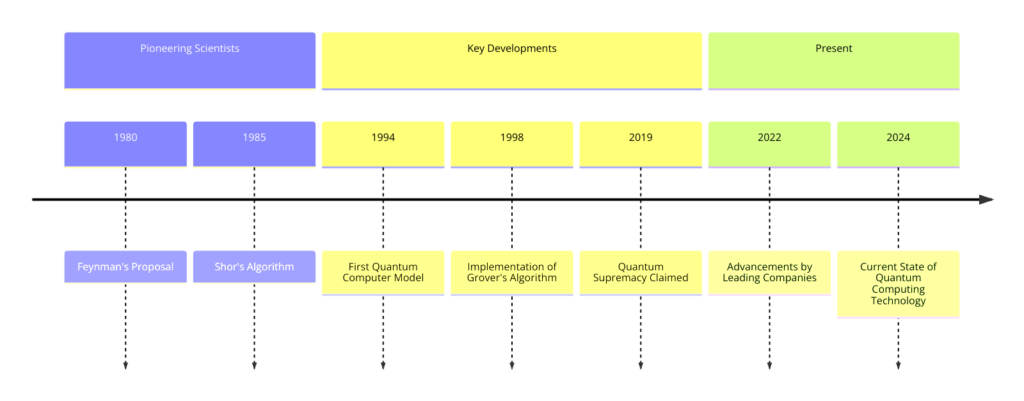
Historical Milestones in Quantum Computing
The journey of quantum computing from a theoretical concept to a tangible technology represents one of the most fascinating chapters in the history of science and technology.
This evolution is marked by several key milestones and the contributions of pioneering scientists who have laid the groundwork for what quantum computing has become today.
The concept of quantum computing was first introduced in the early 1980s when physicists Richard Feynman and David Deutsch independently proposed using a quantum computer to simulate and solve problems in quantum physics that were intractable for classical computers.
Feynman’s insight into the complexity of simulating quantum systems with classical computers led to the revolutionary idea that a computer based on the principles of quantum mechanics could perform such tasks more efficiently.
1994 Peter Shor developed his eponymous algorithm, demonstrating that a quantum computer could factor large numbers exponentially faster than the best-known classical algorithms.
Shor’s algorithm highlighted the potential of quantum computing to revolutionize fields such as cryptography and spurred significant interest and investment in the field.
Another landmark in the history of quantum computing was the development of Grover’s algorithm in 1996. This algorithm provided a quadratic speedup for searching unsorted databases.
Though less dramatic than Shor’s speedup, Grover’s algorithm showcased quantum computing’s broad potential beyond specific applications like factoring.
Over the years, the field has seen substantial progress in developing quantum hardware and algorithms, including realizing small-scale quantum processors and Google’s demonstration of quantum supremacy in 2019.
Google’s achievement, where their quantum processor performed a specific task that would be practically impossible for a classical computer, marked a significant milestone in the field, demonstrating that quantum computing could surpass classical computing for particular tasks.
Current State of Quantum Computing Technology

Today, quantum computing is undergoing rapid development and experimentation.
Leading technology companies, including Google, IBM, and others, are leading this research, developing quantum processors with an increasing number of qubits and more stable quantum states.
The current state of quantum computing technology is characterized by experimental quantum processors capable of performing specific quantum algorithms but still far from the large-scale, general-purpose quantum computers envisioned by researchers.
These systems, often called Noisy Intermediate-Scale Quantum (NISQ) devices, offer a testbed for exploring quantum algorithms, quantum error correction techniques, and various quantum computing applications.
Despite the challenges, the progress in developing more stable and scalable quantum computing systems continues at an impressive pace. Advances in qubit technology, error correction, and quantum algorithms are gradually overcoming the limitations of NISQ devices, paving the way for more practical and impactful quantum computing applications.
The evolution of quantum computing from a theoretical concept to an experimental reality reflects the collaborative efforts of physicists, computer scientists, and engineers.
As the technology matures and becomes more accessible, the next chapter in its history promises to be even more transformative, with the potential to solve some of the world’s most complex problems.
Having traced the evolution of quantum computing from its conceptual beginnings to its current state, our exploration will next venture into the quantum computing era.
5. The Quantum Computing Era

The era of quantum computing is as varied as it is complex, encompassing different models of computation and a range of physical systems that can realize quantum computers.
This diversity highlights the adaptability and potential of quantum computing across various fields and showcases the innovative approaches researchers are taking to overcome the challenges inherent in building quantum systems.
Quantum Computing Models
- Gate Model Quantum Computing: The gate model, also known as the circuit model, is the most widely studied form of quantum computing and mirrors the classical computing approach with a quantum twist. In this model, quantum gates perform qubits-like logical operations on bits in classical computing. However, quantum gates manipulate qubits through quantum mechanics principles, such as superposition and entanglement, enabling complex computations that are infeasible for classical systems. Algorithms like Shor’s and Grover’s were designed with the gate model in mind, highlighting its potential to solve specific computational problems exponentially faster than classical computers.
- Quantum Annealing: Quantum annealing is a specialized form of quantum computing focused on solving optimization problems by finding a system’s lowest energy state. This approach leverages quantum tunneling and superposition to explore a vast solution space than classical algorithms more efficiently. Quantum annealing has been particularly associated with D-Wave Systems, which has developed commercial quantum annealers to solve optimization, sampling, and search problems. While quantum annealing is less general-purpose than the gate model, its optimization and machine-learning applications are promising research and development areas.
Physical Realizations of Quantum Computers
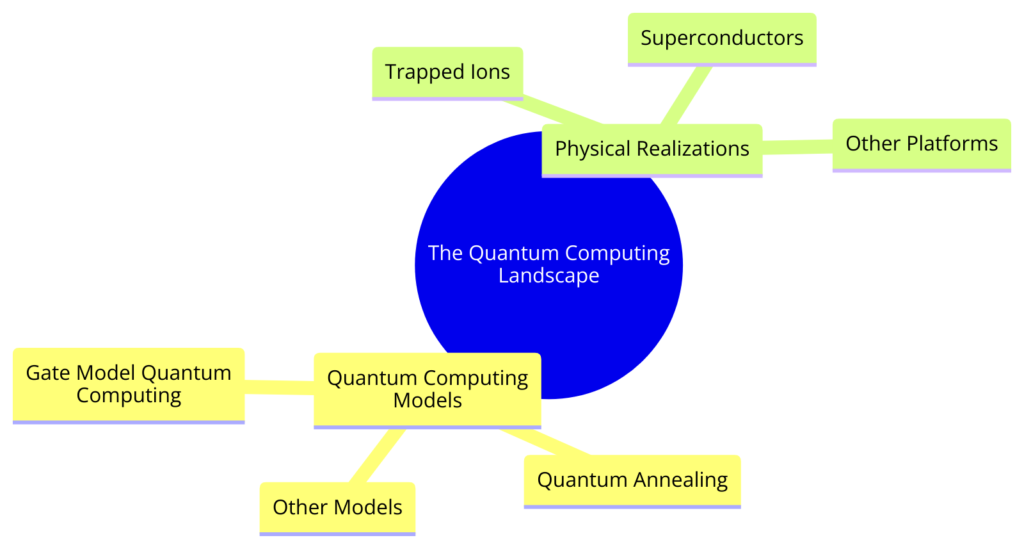
The physical realization of quantum computers can be achieved through various platforms, each with its challenges and advantages. The most prominent platforms include:
- Trapped Ions: Quantum computers using trapped ions leverage ions as qubits, held in place by electromagnetic fields. Laser pulses then manipulate these qubits to perform quantum operations. Trapped ion systems are known for their long coherence times and high fidelity of quantum operations, making them a leading platform for quantum computing.
- Superconducting Circuits: Superconducting quantum computers use circuits from superconducting materials to create qubits. Operated at extremely low temperatures, these systems allow for manipulating qubits through microwave pulses. Companies like IBM and Google have made significant advancements with superconducting qubits, pushing the boundaries of quantum computing.
- Other Platforms: Other approaches to building quantum computers include topological qubits, which use quasiparticles called anyons to encode information, and photonic systems, which use light particles (photons) as qubits. Each platform offers unique advantages and faces distinct challenges, contributing to the diverse quantum computing research and development ecosystem.
The physical realization of quantum computers is a rapidly evolving field driven by advancements in materials science, engineering, and quantum theory.
Despite challenges such as error rates and qubit stability, the development of scalable and robust quantum computing systems continues, with each platform offering unique pathways to harnessing quantum computing’s power.
After understanding quantum computing’s diverse models and physical realizations, we will next explore its applications. Let’s focus on how quantum computing is poised to break encryptions and impact cryptography, followed by its potential to revolutionize simulations and optimizations in fields like material science, pharmaceuticals, logistics, and artificial intelligence.
6. Quantum Computing Applications
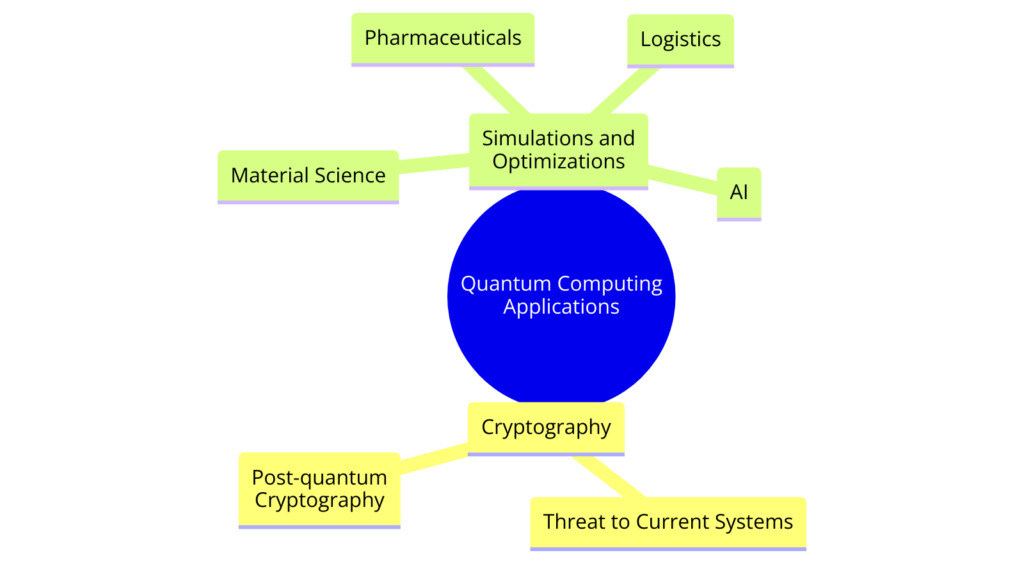
Quantum computing promises to revolutionize a wide array of fields by offering solutions to problems currently beyond the reach of classical computers.
This transformative potential is most evident in its applications to cryptography, simulations, and optimizations across various industries. Let’s dig into quantum computing’s impact on breaking encryptions and its broader implications for cryptography, then explore its revolutionary role in simulations and optimizations.
Breaking Encryptions: The Impact on Cryptography
One of the most talked-about applications of quantum computing is its ability to break widely used encryption methods.
Current encryption schemes, such as RSA and ECC (Elliptic Curve Cryptography), rely on the computational difficulty of problems like integer factorization and discrete logarithms for security.
However, with the advent of quantum computers, these encryption methods are at risk due to algorithms like Shor’s, which can solve these problems exponentially faster than the best-known classical algorithms.
The potential of quantum computing to break current encryption schemes poses a significant challenge to data security and privacy.
It necessitates the development of post-quantum cryptography (PQC), which refers to cryptographic algorithms thought to be secure against an attack by a quantum computer.
Research in PQC focuses on cryptographic schemes that do not rely on the hardness of integer factorization and discrete logarithms but instead on problems that remain hard for quantum computers, such as lattice-based cryptography, hash-based cryptography, and multivariate polynomial cryptography.
The transition to post-quantum cryptography is not merely a technical challenge but also a logistical and policy challenge, requiring widespread updates to encryption standards and practices. Despite these challenges, quantum computing’s threat to current cryptographic systems is also an opportunity to advance cryptographic practices and enhance data security in the quantum age.
Revolutionizing Simulations and Optimizations
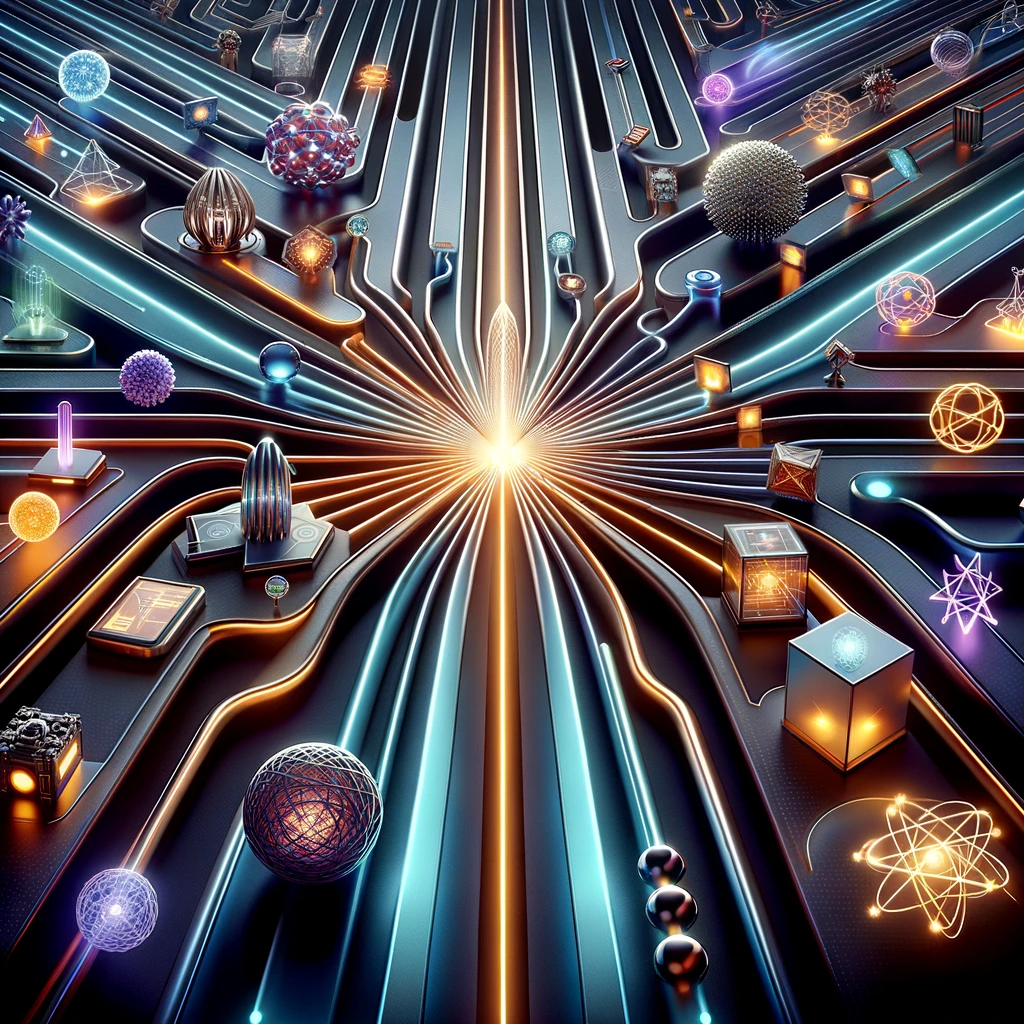
Beyond cryptography, quantum computing is set to transform the fields of simulations and optimizations, offering unprecedented capabilities in material science, pharmaceuticals, logistics, and artificial intelligence (AI).
- Material Science and Pharmaceuticals: Quantum computing can directly simulate quantum systems, an extremely resource-intensive task for classical computers. This capability is revolutionary for material science and drug discovery, where understanding complex molecular structures and interactions is crucial. Quantum simulations could drastically reduce the time and cost of developing new materials and drugs, accelerating innovation and potentially bringing life-saving treatments to market faster.
- Quantum Optimization for Logistics and AI: Quantum computing also offers new horizons in optimization problems, which are fundamental to logistics, supply chain management, and AI. Quantum algorithms for optimization, such as the quantum approximate optimization algorithm (QAOA), can solve complex optimization problems more efficiently than classical algorithms. This could lead to more efficient routing, better resource allocation, and improved decision-making processes in various industries, enhancing operational efficiency and sustainability.
Quantum computing’s applications are broad and varied, reflecting its potential to impact numerous aspects of society and the economy. As research and technology continue to advance, the scope of quantum computing’s applications will likely expand, unlocking new possibilities and challenges.
Having explored quantum computing’s applications in breaking encryptions and revolutionizing simulations and optimizations, our journey will next dig into the future and beyond. Now let’s discuss the roadmap for quantum computing, including research directions and future milestones, as well as the ethical considerations and societal impacts of this emerging technology, offering a holistic view of its potential and challenges as we look toward a quantum future.
7. The Future and Beyond

The trajectory of quantum computing is poised to reshape our technological era, promising breakthroughs across numerous domains while presenting new ethical and societal challenges.
As we peer into the future of quantum computing, it’s essential to consider both the roadmap for its development and the broader implications of its widespread adoption.
The Roadmap for Quantum Computing
Several key research directions and milestones mark the future of quantum computing.
Short- to medium-term goals focus on advancing quantum hardware, improving qubit coherence times, reducing error rates, and developing more efficient quantum error correction methods.
These technical advancements are crucial for scaling quantum computers to solve practical, real-world problems.
One of the most eagerly anticipated milestones in quantum computing is achieving “quantum advantage” for various applications.
Quantum advantage occurs when a quantum computer can solve a problem more efficiently than the best classical computer, offering solutions to problems previously considered intractable.
This milestone has been partially achieved in specific domains, but expanding it across a more comprehensive array of applications is a significant focus of ongoing research.
Looking further ahead, developing a fully functional quantum internet represents one of the most transformative long-term goals.
A quantum internet would enable inherently secure communications, distributed quantum computing, and a new level of integration between quantum computers across the globe.
This would not only revolutionize data security but also enhance quantum computers’ capabilities by enabling them to work together on complex problems.
Ethical Considerations and Quantum Computing
As with any transformative technology, quantum computing raises important ethical considerations that must be addressed to ensure its benefits are realized equitably and responsibly.
Data privacy emerges as a primary concern, especially with the potential of quantum computing to break current encryption standards.
Developing secure cryptographic methods that can withstand the power of quantum computing is crucial to protecting personal and sensitive information.
Another ethical consideration is the digital divide.
The advent of quantum computing could exacerbate existing inequalities in access to computational resources.
Ensuring equitable access to quantum computing technologies and their benefits is essential to preventing the gap between those with and without access to this powerful tool from widening.
Furthermore, quantum computing’s impact on employment and the economy raises questions about workforce displacement and the need for retraining programs.
As quantum computing automates complex tasks and computations, it’s vital to consider how to transition workers into new roles and industries.
Balancing the technological advancement of quantum computing with its societal impacts requires ongoing dialogue among scientists, policymakers, ethicists, and the broader public.
Establishing frameworks for responsible research, development, and deployment of quantum technologies is crucial to harnessing their potential while mitigating risks.
Conclusion
The transformative potential of quantum computing is immense, offering the prospect of solving some of humanity’s most complex and pressing problems.
As we venture further into the quantum era, the journey is filled with exciting opportunities and significant challenges.
By addressing the ethical and societal implications of quantum computing, we can ensure that this revolutionary technology benefits humanity, paving the way for a future where quantum computing fulfills its vast potential.
This exploration of quantum computing, from its fundamentals to its prospects, underscores the transformative impact this technology is poised to have across various sectors. As the field continues to evolve, quantum computing’s promise remains a beacon of scientific and technological progress, inviting us to reimagine the limits of what is computationally possible.
FAQ & ANSWERS
1. Quantum Computing: Unveiling the Quantum Realm
What is quantum computing, and why could it be the next giant technological leap?
Quantum computing is a revolutionary approach to computation that leverages the principles of quantum mechanics. Unlike classical computing, which relies on bits (0s or 1s) for processing information, quantum computing uses qubits. Thanks to superposition, qubits can exist in multiple states simultaneously. This ability enables quantum computers to process vast amounts of data at unprecedented speeds, potentially solving complex problems currently infeasible for classical computers.
How does quantum mechanics fundamentally change the way we think about computing?
Quantum mechanics introduces concepts like superposition and entanglement, allowing particles to be in multiple states at once and instantaneously connected, respectively. These principles defy classical logic and computing norms, enabling quantum computers to perform many calculations simultaneously and solve certain types of problems much more efficiently than traditional computers.
2. The Fundamentals of Quantum Computing
How do quantum computers differ from classical ones, and what makes them so powerful?
The critical difference lies in the basic computation unit: classical computers use bits, while quantum computers use qubits. This difference allows quantum computers to process complex calculations more efficiently, especially for tasks involving optimization, simulation, and factoring large numbers.
Can you explain the concept of qubits and superposition in simple terms?
Imagine a sphere where any point on the surface represents the state of a qubit. Unlike a classical bit that can be either 0 or 1 (north or south pole on the sphere), a qubit can be any point on the sphere, representing a combination of 0 and 1 simultaneously, thanks to superposition. This property allows quantum computers to perform multiple calculations at once.
What is quantum entanglement, and why is it crucial for quantum computing?
Quantum entanglement is a phenomenon in which particles become interconnected, and the state of one (no matter the distance from the other) can instantaneously affect the state of another. This principle is crucial for quantum computing as it allows for incredibly fast and complex computations through the correlated behavior of qubits, enhancing processing power beyond classical computing methods.
How do quantum algorithms work, and why are Shor’s and Grover’s algorithms often highlighted?
Quantum algorithms use quantum mechanics to solve problems more efficiently than classical algorithms. Shor’s algorithm, for instance, can factor large numbers much faster than the best-known classical algorithm, potentially breaking current encryption methods. Grover’s algorithm improves the speed of searching unsorted databases by a quadratic factor, showcasing the potential of quantum computing to outperform classical computing in specific tasks vastly.
3. The Evolution of Quantum Computing
What have been the key milestones in the development of quantum computing?
Significant milestones include the conceptualization of quantum bits and quantum logic gates in the 1980s, the development of Shor’s and Grover’s algorithms in the 1990s, the first demonstration of a quantum computer solving a problem faster than a classical computer (quantum supremacy) by Google in 2019, and the ongoing advancements in creating more stable and powerful quantum computers.
Who are the pioneering scientists behind quantum computing, and what were their contributions?
Pioneers like Richard Feynman, who first proposed the idea of a quantum computer in 1982, and David Deutsch, who developed the quantum Turing machine, laid the theoretical foundations. Peter Shor and Lov Grover developed algorithms showing quantum computing’s potential to revolutionize computing tasks.
What is the current state of quantum computing technology, and which companies are leading the way?
As of my last update, companies like IBM, Google, and Rigetti are at the forefront of quantum computing. They are developing quantum processors with increasing numbers of qubits and exploring applications ranging from cryptography to drug discovery. Quantum computing is still in the early stages, with significant research focused on improving qubit coherence times and error rates.
How did the achievement of quantum supremacy change the field of quantum computing?
Quantum supremacy, demonstrated by Google in 2019 when their quantum computer solved a specific problem faster than the world’s most powerful supercomputer, marked a pivotal moment. It provided tangible proof of quantum computing’s potential to surpass classical computing, fueling investments, research, and interest in the field.
4. The Quantum Computing Landscape
What are the different quantum computing models, and how do they compare?
The primary models are the gate model and quantum annealing. The gate model, akin to classical computing’s logic gates, performs operations using quantum logic gates and is suitable for various applications. Quantum annealing solves optimization problems by finding a system’s lowest energy state, making it ideal for specific tasks like optimization and material science.
What challenges are scientists facing in building quantum computers, and how are they overcoming them?
Challenges include maintaining qubit stability (coherence), error rates, and scaling up the number of qubits. Scientists are exploring various qubit technologies, such as trapped ions and superconducting circuits, and developing error correction techniques to overcome these hurdles.
5. Quantum Computing Applications
How could quantum computing break current encryption methods, and what is being done to prepare for this?
Quantum computing could break encryption methods like RSA, which rely on the difficulty of factoring large numbers—a task Shor’s algorithm can do efficiently. In response, researchers are developing post-quantum cryptography algorithms resistant to quantum attacks, aiming to secure data in the quantum era.
In what ways could quantum computing revolutionize material science, pharmaceuticals, logistics, and AI?
- Material Science: Simulating complex molecules accurately to discover new materials.
- Pharmaceuticals: Speeding up drug discovery by simulating molecular interactions.
- Logistics: Optimizing complex distribution networks more efficiently.
- AI: Enhancing machine learning algorithms through faster processing and new quantum algorithms.
6. The Future and Beyond
What is the roadmap for quantum computing, and what are the following significant milestones?
The roadmap includes improving qubit coherence, reducing error rates, and scaling up the number of qubits for practical, error-corrected quantum computers. Key milestones involve developing quantum algorithms to solve real-world problems and integrating quantum computing into industries for practical applications.
How should we approach the ethical considerations of quantum computing, especially concerning data privacy?
We must develop secure communication technologies, like quantum key distribution, and establish regulations that protect data privacy in a quantum computing world. Engaging in global discussions on the ethical use of quantum computing is essential to balance technological advancement with societal impacts.
7. Conclusion
Reflecting on everything discussed, what is the transformative potential of quantum computing?
Quantum computing holds the potential to revolutionize various fields by solving complex problems intractably for classical computers. Its implications for cryptography, drug discovery, optimization problems, and beyond could significantly impact how we approach computation, security, and scientific research.
How should society prepare for the future landscape shaped by quantum computing advancements?
Society must invest in education, research, and ethical discussions to prepare for the quantum computing era. Developing new standards for data security, fostering global cooperation in research, and considering the societal impacts of quantum technology are crucial steps toward a future where quantum computing benefits all.
Quizzes
Quiz 1: Basics and Fundamentals of Quantum Computing
1. What distinguishes quantum computing from classical computing?
- A. Quantum computing uses binary digits.
- B. Quantum computing is based on the principles of quantum mechanics.
- C. Classical computing can perform calculations faster than quantum computing.
- D. Classical computing utilizes qubits for data representation.
2. What is a qubit in the context of quantum computing?
- A. A traditional binary digit.
- B. A unit of quantum information that can exist in multiple states simultaneously.
- C. A type of quantum algorithm.
- D. A physical device that stores quantum data.
3. Quantum entanglement is a phenomenon that:
- A. Allows classical computers to process information faster.
- B. Has no real application in computing.
- C. Enables qubits to be interconnected, affecting each other’s state instantly, regardless of distance.
- D. Is only a theoretical concept and has not been proven.
4. Which quantum algorithm is renowned for its potential to factor large numbers efficiently?
- A. Grover’s algorithm
- B. Shor’s algorithm
- C. Quantum annealing
- D. The gate model
5. Quantum supremacy is a term used to describe:
- A. The dominance of quantum computers in the gaming industry.
- B. A quantum computer’s ability to solve a problem that classical computers cannot solve in a feasible amount of time.
- C. The theoretical limit of quantum computing power.
- D. The superior ethical standards in quantum computing research.
Answers for Quiz 1: Basics and Fundamentals of Quantum Computing
- What distinguishes quantum computing from classical computing?
- Correct Answer: B. Quantum computing is based on the principles of quantum mechanics.
- What is a qubit in the context of quantum computing?
- Correct Answer: B. A unit of quantum information that can exist in multiple states simultaneously.
- Quantum entanglement is a phenomenon that:
- Correct Answer: C. Enables qubits to be interconnected, affecting each other’s state instantly, regardless of distance.
- Which quantum algorithm is renowned for its potential to factor large numbers efficiently?
- Correct Answer: B. Shor’s algorithm
- Quantum supremacy is a term used to describe:
- Correct Answer: B. A quantum computer’s ability to solve a problem that classical computers cannot solve in a feasible amount of time.
Quiz 2: Applications, Challenges, and the Future of Quantum Computing
1. Which area is NOT expected to be revolutionized by quantum computing?
- A. Social media algorithms
- B. Cryptography
- C. Material science
- D. Pharmaceutical development
2. What is post-quantum cryptography?
- A. A new algorithm designed exclusively for quantum computers.
- B. Cryptography that relies on quantum mechanics.
- C. Cryptographic methods secure against quantum-computer attacks.
- D. A branch of mathematics that studies quantum algorithms.
3. One of the challenges in building quantum computers is:
- A. Finding enough classical computers to integrate.
- B. The physical realization of qubits, such as through trapped ions or superconductors.
- C. Designing aesthetically pleasing models for consumers.
- D. Developing algorithms that can only run on classical computers.
4. The concept of a quantum internet revolves around:
- A. Faster browsing speeds.
- B. Quantum entanglement for instantaneous communication over long distances.
- C. Streaming services exclusively for quantum computers.
- D. A new social media platform for quantum scientists.
5. What is a significant ethical consideration in the age of quantum computing?
- A. The design of quantum computer cases.
- B. Data privacy, considering quantum computing’s potential to break current encryption methods.
- C. The color of the quantum computers.
- D. The impact of quantum computing on classical music.
Answers for Quiz 2: Applications, Challenges, and the Future of Quantum Computing
- Which area is NOT expected to be revolutionized by quantum computing?
- Correct Answer: A. Social media algorithms
- What is post-quantum cryptography?
- Correct Answer: C. Cryptographic methods secure against quantum-computer attacks.
- One of the challenges in building quantum computers is:
- Correct Answer: B. The physical realization of qubits, such as through trapped ions or superconductors.
- The concept of a quantum internet revolves around:
- Correct Answer: B. Quantum entanglement for instantaneous communication over long distances.
- What is a significant ethical consideration in the age of quantum computing?
- Correct Answer: B. Data privacy, considering quantum computing’s potential to break current encryption methods.




